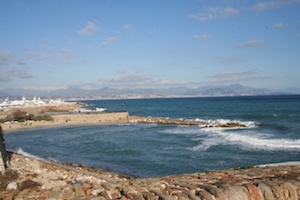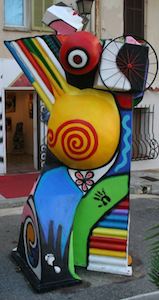By Barbara Hopkins
 Perched on the shore of the Baie des Anges and lapped by its turquoise waters, steeped in history and art, a foodie’s delight with a safe beach, over 300 days of Mediterranean sun per year in which to savor it all — and a green fairy to flirt with. What’s not to like about Antibes?
Perched on the shore of the Baie des Anges and lapped by its turquoise waters, steeped in history and art, a foodie’s delight with a safe beach, over 300 days of Mediterranean sun per year in which to savor it all — and a green fairy to flirt with. What’s not to like about Antibes?
This historic little town on the French Riviera is a relaxed and easy-going partner to its neighbor, Juan-les-Pins. Often uttered in the same breath as Antibes-Juan-les-Pins, Antibes has charm, character, and a relaxed, easy-going vibe in contrast to its brasher, more glitzy neighbor.
Antibes is bathed in the intense, luminous quality of light which attracted painters to the Riviera whose names read like an artistic roll call in Who’s Who: Picasso, Matisse, Renoir, Signac, and Chagall established themselves in the region, while Claude Monet was a frequent visitor. The area attracted many writers, too, including Graham Greene, who spent the last years of his life in Antibes, and F. Scott Fitzgerald, who set Tender Is The Night here.
Drenched in sunshine and quintessentially Mediterranean in character, Antibes’ narrow cobblestone streets reveal a maze of tall red-tiled houses. Their overflowing window boxes tumble with flowers, each one clearly trying to outdo its neighbors for a show of riotous color.
The 16th century ramparts guarding the vielle ville are a popular walk, with the Promenade Amiral de Grasse providing picture-postcard views. The ramparts are also the backdrop for the little beach of Plage de la Gravette (quai Henri Rambaud) which is tucked away at the ramparts’ end. Popular with locals, the fine white sand and clear, shallow water make an idyllic and safe spot for sun worship and swimming.
 Further along the ramparts is the imposing grandeur of Chateau Grimaldi, which now houses the Musee Picasso (Place Mariejol). Picasso lived here for just a few months in 1946, but left a number of works to the town which he briefly called home. The museum now houses one of the greatest collections of his paintings, ceramics, and lithographs, and is the first museum dedicated to him. The terraced sculpture garden affords more memorable views along the bay, looking towards Nice and the snow-tipped peaks of the Alps in one direction and Cap d’Antibes in the other.
Further along the ramparts is the imposing grandeur of Chateau Grimaldi, which now houses the Musee Picasso (Place Mariejol). Picasso lived here for just a few months in 1946, but left a number of works to the town which he briefly called home. The museum now houses one of the greatest collections of his paintings, ceramics, and lithographs, and is the first museum dedicated to him. The terraced sculpture garden affords more memorable views along the bay, looking towards Nice and the snow-tipped peaks of the Alps in one direction and Cap d’Antibes in the other.
Don’t miss the sprawling Marche Provencal (Cours Massena). This bustling market is a hectic kaleidoscope of color with aromas to assault the senses. It’s just the place to assemble a picnic lunch to eat on the beach or on the ramparts overlooking the azure waters of the bay. Open every day until 1 p.m., the market is a food-lover’s delight, with stalls groaning under the weight of fruit, vegetables, and olives all bursting with flavor from their exposure to the blazing Mediterranean sun.
While at the market, call into the Absinthe Bar (25 Cours Massena, underneath the olive oil shop Balade de Provence) and discover why Degas’ 1876 painting L’Absinthe provoked such outrage.
The enthusiastic staff like nothing better than to share their enthusiasm for the 25 varieties of this spirit which has acquired such a reputation. The ceremony of absinthe drinking with perforated spoon, sugar, and water is known as “flirting with the green fairy” — but there are plenty of other drinks on offer for those who wish to leave the fairy alone!
Graham Greene is reputed to have said that Antibes was the only town on the Riviera which hadn’t lost its soul. Whether he has been accurately quoted isn’t clear — but I can’t help but agree with the sentiment.
If you would like to purchase this article for your publication, please click here to contact the author directly.
